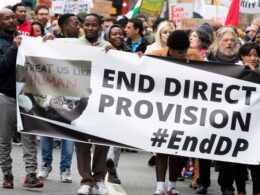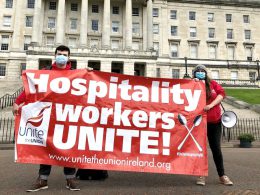By Eddie McCabe
Sinn Féin had been declining in opinion polls for months before the local and European elections, and it was clear to anyone canvassing in working-class estates that the elections were not going to be what SF had hoped for. Not only was there far less positivity towards Sinn Féin, which existed palpably during the 2020 general election, but an unexpected hostility towards the party was evident. It wasn’t unusual to be met with comments like “as long as you’re not Shinners”.
Still, the final vote share of 12% was a dramatic fall that nobody could have predicted. Some Sinn Féin reps and supporters have tried to diminish this collapse by pointing to the fact that its vote did increase compared to the last local elections in 2019 – it gained 21 new councillors for a total of 102. They also point to the fact that Fine Gael and Fianna Fáil, who are swanning around giddily since the election, actually lost votes and a combined 41 seats.
This is all true, but for a party whose leader only weeks ago insisted she was confident all 335 candidates could be elected, such talk smacks of an unwillingness to really face up to the deep crisis it’s now in.
Moving rightwards
For the last few years, especially coming out of the pandemic, Sinn Féin had been riding a popular wave in the South – not so much of support for its particular brand or ideas, but of being the largest political force that’s not FG or FF. Sinn Féin clearly believed, as did many commentators, that all it had to do was keep steady and ride this wave up to the next general election, which would surely be even more successful for it than 2020.
Such a notion was clearly wrong. The crises in society – particularly in housing, health and care – are too serious for such a limp position to maintain people’s confidence. But in reality, rather than just keeping steady, Sinn Féin has been shifting rightwards, away from its more radical 2020 postures. Its recent message to investment group Davy, which was summed up by Davy as being “More New Labour than Corbyn Labour”, typifies the approach.
Sinn Féin could argue that it is being unfairly blamed for things it isn’t yet responsible for – being still in opposition not in government. But it can hardly complain about being viewed by growing numbers as part of the establishment when this is the message it is consciously sending out – explicitly to big business, but implicitly to the watching public. People see its moderation of its policies and rhetoric for what it is, they see its lack of action outside the Dáil, and they see its weak responses to political challenges – most notably on Palestine and immigration.
How not to respond to the far right
Along with the socialist left, Sinn Féin has been targeted by far-right groups. They do this because right now they are trying to carve out bases in the hardest pressed working-class communities, where Sinn Féin and the left – not the government parties – have strong support. Feeling this pressure, Sinn Féin’s response has not been to rebut the far right’s lies, but to echo them – declaring in the leaflets of all of its candidates that “Sinn Féin is opposed to open borders”. Of course, we don’t have open borders; we have the brutality of Fortress Europe!
The problem for Sinn Féin is that this response won’t satisfy its far-right critics, nor those influenced by them. It will, however, alienate those looking for a progressive or left alternative. Young people, for example, have been an important base for Sinn Féin in recent years, and they largely didn’t turn out in the June elections – a key factor in the disparity between 2020 and 2024.
The question now is what Sinn Féin will do in the months leading to the general election – will it shift further right or tack left? The former is probably more likely, and more in line with its real political position and trajectory. Regardless, the responsibility of the left is not to give Sinn Féin cover for its duplicity, or be seen to act as its left advisors, but to clearly outline the difference between Sinn Féin’s approach and a genuine left and socialist approach. Anything else would make the left complicit in Sinn Féin’s inevitable sell-out, and be a gift to the far right.












